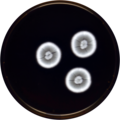Aspergillus rambellii is a species of fungus in the genus Aspergillus. It is from the Ochraceorosei section. The species was first described in 2005. It accumulates very large amounts of sterigmatocystin, 3-O-methylsterigmatocystin and aflatoxin B1.
Aspergillus jensenii is a species of fungus in the genus Aspergillus. It is from the Versicolores section. The species was first described in 2012.
Aspergillus subversicolor is a species of fungus in the genus Aspergillus. It is from the Versicolores section. The species was first described in 2012.

Aspergillus tennesseensis is a species of fungus in the genus Aspergillus. It is from the Versicolores section. The species was first described in 2012.
Aspergillus astellatus is a species of the genus of Aspergillus. It is from the Nidulantes section. Aspergillus astellatus produces Aflatoxin B1, Aflatoxin B2 and sterigmatocystin.
Aspergillus qinqixianii is a species of fungus in the genus Aspergillus which has been isolated from desert soil from the Taklimakan desert in China. It is from the Nidulantes section. Aspergillus qinqixianii produces asteltoxin, asperthecin, emericellin, 2-ω-hydroxyemodin, shamixanthones, terrein, curvularin and dehydrocurvularin.
Aspergillus olivicola is a species of fungus in the genus Aspergillus. It is from the Nidulantes section. The species was first described in 2008. It has been isolated from fruit in Italy. A. olivicola has been shown to produce aflatoxin B1, emericellin, shamixanthone, siderin, sterigmatocystin, terrein, and varitriol.
Aspergillus venezuelensis is a species of fungus in the genus Aspergillus. It is from the Nidulantes section. The species was first described in 2004. It has been shown to produce aflatoxin B1 and sterigmatocystin.
Aspergillus navahoensis is a species of fungus in the genus Aspergillus. It is from the Nidulantes section. The species was first described in 1982. It was isolated from sand in Arizona, United States. It has been reported to produce averufin, norsolorinic acid, 6,7,8-trihydroxy-3-methylisocoumarin, desferritriacetylfusigen, echinocandin B, and sterigmatocystin.
Aspergillus quadrilineatus is a species of fungus in the genus Aspergillus. It is from the Nidulantes section. The species was first described in 1939. It has been isolated from soil in New Jersey, Egypt, Spain, China, and Namibia. It has been reported to produce asperthecin, averufin, 7-methoxyaverufin, sterigmatocystin, versicolourin, desferritriacetylfusigen, echinocandin B & E, variacoxanthone B, emestrin, aurantioemestrin, dethiosecoemestrin, emindol DA, microperfuranone, penicillin G, quadrilineatin, and sterigmatocystin.
Aspergillus bicolor is a species of fungus in the genus Aspergillus. It is from the Aenei section. The species was first described in 1978. It has been reported to produce sterigmatocystin, versicolorins, and some anthraquinones.
Aspergillus nutans is a species of fungus in the genus Aspergillus. It is from the Cervini section. The species was first described in 1954. It has been reported to produce terremutin and some carotenoid-like extrolites.
Aspergillus spinulosporus is a species of fungus in the genus Aspergillus. It is from the Nidulantes section. It was first described in 2016. It has been reported to produce asperthecin, echinocandin B1, desferritriacetylfusigen, and sterigmatocystin.
Aspergillus unilateralis is a species of fungus in the genus Aspergillus. It is from the Fumigati section. Several fungi from this section produce heat-resistant ascospores, and the isolates from this section are frequently obtained from locations where natural fires have previously occurred. The species was first described in 1954. It has been reported to produce aszonapyrones and mycophenolic acid.
Aspergillus viridinutans is a species of fungus in the genus Aspergillus. The species was first isolated in Frankston, Victoria, Australia and described in 1954. It is from the Fumigati section of Aspergillus. Several fungi from this section produce heat-resistant ascospores, and the isolates from this section are frequently obtained from locations where natural fires have previously occurred. A. viridinutans has been identified as the cause of chronic aspergillosis. The mycotoxin viriditoxin was first identified in A. viridinutans. A draft genome sequence of the strain derived from the original species description has been generated.
Aspergillus askiburgiensis is a species of fungus in the genus Aspergillus. It is from the Nidulantes section. The species was first described in 2016. It has been isolated from cave sediment in the Czech Republic. A. askiburgiensis has been reported to produce sterigmatocystin, versicolorins, and cf. monascorubramin.
Aspergillus cleistominutus is a species of fungus in the genus Aspergillus. It is from the Nidulantes section. It has been reported to produce arugosin A, arugosin B, arugosin C, asperthecin, aspertetronin A, aspertetronin B, echinocandin B, echinocandin C, echinocandin D, epishamixanthone, shamixanthone, orsellinaldehyde, penicillin G, ruguloxanthone, and sterigmatocystin. It has been isolated from soil in New Jersey, United States.
Aspergillus croceus is a species of fungus in the genus Aspergillus. It is from the Nidulantes section. The species was first described in 2016. It has been isolated from cave sediment in Spain. It has been reported to produce kotanins, norsolorinic acid, orlandin, siderin, sterigmatocystin, and versicolorins.
Aspergillus purpureus is a species of fungus in the genus Aspergillus. It is from the Nidulantes section. The species was first described in 1975. It has been isolated from soil in Egypt. It has been reported to produce emindol SA, emindol SB, emindol SC, epurpurin A-C, sterigmatocystin, variecolactone, variecolin, and variecolol.
Aspergillus striatulus is a species of fungus in the genus Aspergillus. It is from the Nidulantes section. The species was first described in 1985. It has been isolated from mangrove mud in the Kagh Islands. It has been reported to produce asperthecin, aurantioemestrin, cycloisoemericellin, desferritriacetylfusigen, dithiosilvatin, emindol SA, emindol SB, 7-Hydroxyemodin, paxillin, 1-O-acetylpaxillin, penicillin G, sterigmatocystin, violaceic acid, violaceol I, and violaceol II.


